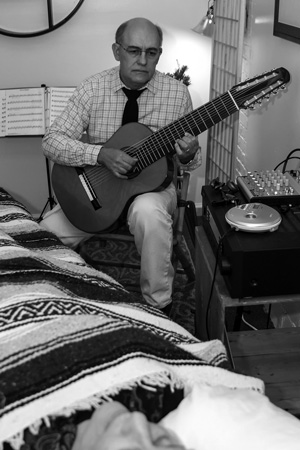News November 2014
Seeking the inner harmony
‘Vibroacoustic’ technique taps healing power of musical vibrations
 By STACEY MORRIS
By STACEY MORRIS
Contributing writer
GLENS FALLS, N.Y.
The asphalt streets of downtown Glens Falls are only a few hundred feet from Dennis Dominick’s office on Thomson Street office, but in figurative terms, the concrete jungle and all of its stressors are a million miles away.
Inside, Dominick has created a cocoon of tranquility in the darkened, two-room office where he practices vibroacoustic therapy.
On a recent afternoon, Dominick sat in a straight-back bamboo chair, cradling a 10-string harp guitar. Next to him on a massage table was a middle-aged woman who sought Dominick’s help for insomnia. The massage table is equipped with a vibroacoustic mat, which he said converts the musical sounds into vibrations a person can feel. The mat uses transducer “speakers” that vibrate rather than move air.
For the next hour, Dominick played a series of improvised chords and melodies. He said these are geared to each client’s specific needs at the time.
Dominick has been practicing at his Glens Falls office for more than a year and says clients come to him for ailments and conditions ranging from everyday stress to sleep disorders, migraine headaches, post-traumatic stress disorder, attention deficit disorder and Parkinson’s disease.
He is a certified music practitioner, a credential issued by the nonprofit Music for Healing and Transition Program Inc. The national organization trains people who sing or play live instrumental music as therapy for those who are ill or dying.
Unlike pre-recorded relaxation tapes, Dominick says the one-on-one technique he employs is a more beneficial form of music therapy because it is customized to the needs to each client in a given moment.
“I change things moment by moment when I play therapeutic music,” he explained. “The scales, notes, melodies, and spaces between the notes all change based on what I’m perceiving from the client. I pay attention to their facial expressions, skin color and body language. It’s all improvised and is truly a custom treatment.”
Garage band to hospice care
Dominick grew up in Saratoga Springs, where much of his free time was spent playing guitar with buddies in a garage band after school.
“I’m self-taught and have been playing guitar since the age of 13,” he said with a smile. “They didn’t offer music classes at St. Peter’s School.”
Not being able to read music didn’t stop Dominick from performing Beatles’ and Rolling Stones’ songs with his band, and after graduation he played in folk bands around the Spa City in the late 1960s.
Although for many years he had a career in the printing industry, Dominick eventually found himself drawn to music again, this time for therapeutic purposes after he became a hospice volunteer 20 years ago.
“I began by taking my guitar to visit patients when it felt appropriate,” he recalled.
Several years ago, Dominick said he read a story in the Hill Country Observer about Melinda Gardiner, a registered nurse in Columbia County who became a certified music practitioner and now serves as executive director of the Music for Healing and Transition Program. He got in touch with Gardiner and wound up completing the certification himself.
Later, he studied and became part of the first graduating class of Vibroacoustic Therapy International, an organization based in the Toronto area.
Dominick said vibroacoustic therapy focuses more on using lower-resonance pitches, which are measured in hertz.
“Lower hertz are the ones that have been proven beneficial for vibroacoustic therapy, and my 10-string guitar is good for that,” he said. “The body is a mass of solids and liquids. Vibrations from the instrument and the vibroacoustic mat go into the body, and the cells experience them on a physical level.”
The process, he said, brings brain waves down quickly from beta, or high activity, to alpha, the state where one begins to fall asleep, to theta, “which is where you want to be for healing.”
Roots in treating autism
The origins of Vibroacoustic therapy can be traced back nearly 40 years to Norway, where Olav Skille developed the method for helping children with autism.
“He started by using sound vibrations on children in his clinic, with good results,” Dominick said. “Skille found that the children responded to other methods of therapy better when sound vibration was used, and that led him to use sound vibration on other conditions, such as Parkinson’s and multiple sclerosis. It’s also a great healing technique for people who don’t enjoy being touched or massaged, either for mental or physical reasons. Vibroacoustic therapy is like an internal massage.”
Jennifer Miner of Glens Falls said she has been receiving regular vibroacoustic therapy treatments from Dominick for the past 10 months, in part to manage stress from a divorce and also to address numbness in her foot from sitting for hours at a desk job.
“I felt an immediate reduction in my stress levels, and the numbness in my foot also responded very, very well,” she said. “I love the idea of everyone resonating at their own frequency. I’ve found this to be a great help in getting me refocused and adapting to the various stresses of life.”
Dominick said that although vibroacoustic therapy is now covered by insurance in Europe, the United States still tends to view it as an “out there” alternative therapy.
“Western medicine has two tools: surgery and pharmaceuticals,” he said.
The standard notion that physical ailments can be cured by something as easy as taking a pill sets unrealistic expectations for some of his clients, Dominick said.
“When people come to vibroacoustic therapy, that’s what they expect: They’re going to get on the table and suddenly get better,” he said. “That can occur, but it’s not likely. What does occur is you participate in the process, directing body to heal.”
Academic studies under way
Dominick recommends his clients use three-session packages to work on a particular issue. He charges $120 for a three-session packages and $250 for a seven-session package. Each session is about 90 minutes, including a pre-therapy discussion of the client’s symptoms or conditions that need attention.
He said he’s hopeful that some day the therapy will be more widely accepted as a viable health-care option.
“For some reason, college kids are fascinated by vibroacoustic therapy, and because of this, tons of papers and theses have been written on trials and benefits,” Dominick said. “So when it finally comes time to cover this with health insurance, there will be some documented proof.”
For his own experience, he said he doesn’t need additional proof.
“The vibrations are beneficial, period,” Dominick said. “I’m also teaching people how to use that altered state to heal their bodies themselves and get their mind in a better place to benefit their own healing. One of the precepts of Tibetan medicine is that the patient has to believe in the possibility that they can heal.
“When you hear music, it can change you in an instant,” he said. “Music can be used to help regulate blood pressure and heart beat, depending on scale, melody, and mode. Music can bypass the analytical mind and help channel a person into that place where they’re susceptible to a healing state.”
Apart from his private vibroacoustic therapy sessions, Dominick works with Saratoga Springs-based psychotherapist April Hannah at her Van Dam Street office for twice-monthly group meditations.
“April takes participants through a journey, and I play appropriate music that goes along with what she’s saying,” he explained. “She has found that clients are able to go deeper with the vibroacoustic therapy complementing her meditation.”
Hannah said Dominick’s participation has helped her as well as others in the meditation group.
“The group also gets the benefit of Dennis feeling the energy in the room and knowing what chords and notes to play that will elicit an even deeper relaxation response,” she explained. “The individual sessions I’ve had with him have increased my energy greatly and put me in a clearer state of mind.”
Dominick’s future plans include working with Hannah on a music therapy workshop for veterans suffering from post-traumatic stress disorder and setting up a program of vibroacoustic therapy for nursing home patients.
“This type of therapy releases chemicals in the brain associated with joy and pleasure,” Dominick said. “These chemicals are normally released during exercise, and most nursing home residents don’t get an opportunity for that.”
He’s also looking forward to the arrival of a new 13-string guitar early next year.
“It’s being built right now in the Ukraine and will have lower notes on it,” Dominick said.
For more information on vibroacoustic therapy and upcoming workshops, visit www.DennisDominick.com or call (518) 361-5343.

